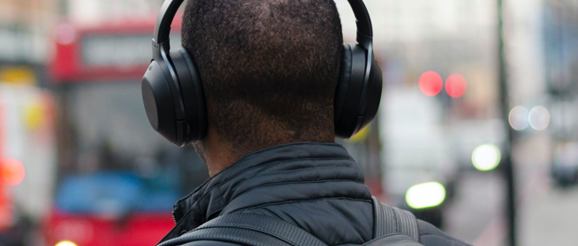Strong ROI and bold innovation propel podcasts into the marketing mix

There are few stories in media more compelling than the recent surge of the podcast. The medium is so dynamic that conversations with friends now often involve listing favorite audio downloads ahead of songs or TV shows.
There’s a serious side to this for advertisers too. At a time of economic uncertainty, when brands are looking for increased evidence of effectiveness, studies show that podcasts deliver healthy returns for those that commit spend to the medium.
Advertising in digital audio, such as podcasts, gives 60% higher return-on-investment (ROI) compared to other media channels, according to recent research commissioned by Acast and Spotify in Sweden.
To consider this strong ROI delivery, alongside the opportunities and innovation that exist within audio for brands, The Drum partnered with Acast, the home of podcast advertising, for a video discussion titled ‘The podcast download – an essential part of the marketing mix in any budget climate.’
Joining Jenni Baker, assistant editor, for a session as part of The Drum’s Audio Deep Dive were podcast experts Joe Copeman, senior vice-president of ad sales at Acast, and Elli Dimitroulakos, global head of ad innovation at Acast.
High-profile creators
Copeman set the scene with the “how and why” podcasts have experienced such a boom time. He described the impact that Covid-19 had upon the entertainment industry, with huge numbers of new creators entering the space during lockdown, including some very high-profile celebrities. This, combined with the rise of accessible tech making it easier for podcasters to host their own shows and reach significant audiences, has driven the massive popularity of the medium.
Advertising revenues are also helping to attract and sustain podcast talent, which is bringing in fresh and diverse audiences. Some 45% of listeners are new to podcasts in the past 12 months, says Copeman, and the audience encompasses a whole range of age groups – 65% of over-55s have started listening to podcasts in the past years. Millennial audiences have grown 113%, and gen Z by 175%, he added.
High levels of attention
The discussion next addressed the amount of time listeners actively choose to spend with podcasts. With brands increasingly interested in the benefits of “the attention economy”, 64% of podcast listeners give their full attention while listening, and 68% agreed that podcast ads “standout” and have more “clarity” than in music or radio, according to recent Acast research.
Copeman added: “Advertisers know that they’re going to get a listener with heightened attention. And that means a lot because it’s great for brand recall. And it’s not just about remembering the ad, it’s about how you feel about the ad as well.”
He argued that when celebrities and podcasts endorse products that are right for them it resonates with listeners: “It’s attention, it’s authenticity. And it’s the fact that you’re in a positive frame of mind when you listen to these podcasts as well.”
New levels of innovation
Advertisers are also looking to podcasts for innovation. Dimitroulakos explained that Acast is working on “creating products and targeting capabilities that bring you closer to the conversations without losing the intimacy that is created between the listener and the podcaster.”
She described how conversational targeting, a piece of proprietary technology that takes artificial intelligence and transcription data from 66,000 podcasts in the marketplace, surfaces specific data signals that provide brands with an understanding of the conversations being had at the episode level.
“Advertisers can now actually look in through a lens of what those conversations are, and decide whether that conversation makes sense with what they’re promoting, or the service they’re offering,” she said. “So it’s in alignment with their brand purpose, but also the listener themselves.”
Products and services that enable advertisers to be more purposeful and brand safe in the podcast environment are also emerging. These include a partnership between Comscore and Acast that judges the brand suitability of podcasts, based on the specific conversations within each podcast. It can also be used to encourage diversity and inclusion initiatives by ensuring that words used in context by specific groups or communities don’t lead to the inadvertent blocking of content.
Dimitroulakos said: “This is our way of keeping brands safe, making sure they’re aligned with content that makes sense, but also keeping the center of the conversation in mind in terms of what categories of brand suitability they fall in.”
ROI at scale
The discussion moved to cover the ability of advertisers to scale audiences and create greater levels of targetability by combining podcast reach with that of, for instance, connected TV (CTV). And Dimitroulakos noted that Acast is working alongside the IAB on standards around brand safety and effectiveness for advertisers.
Copeman then mentioned specific podcast campaigns from brands, including Klarna’s recent activity ‘Money Talks’, the brainchild of Acast’s in-house creative team Acast Creative, which involved collaborating with podcasters including Kate Thornton and Ralph Little getting candid about their financial decisions, breaking the taboo of talking about finance. He also referenced an approach for the Sainsbury’s ‘Taste the Difference’ range which harnessed a rich range of media including video content, social feeds, and 360-degree camera work.
But what’s next for brands in terms of innovation in digital audio? Dimitroulakos said a renewed focus on working with advertisers towards “campaigns that are more scalable, more effective and smarter as well.”
And is there clear advice to advertisers to achieve this? Dimitroulakos added: “Come into it with a fresh lens, and let the experts show you. Like, what are the KPIs you should be measuring? How do you effectively reach the listener? How do you connect them with creative that makes sense, because trying to mirror the KPIs or the media execution from display or video, or some other mediums like even radio, they don’t naturally translate over.”
Watch the full discussion above.
